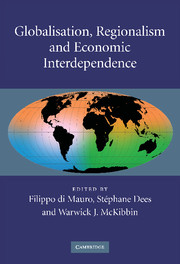Book contents
- Frontmatter
- Contents
- List of figures
- List of tables
- List of contributors
- Preface
- Introduction
- 1 International linkages in the context of global and regional integration
- 2 Trade integration of the central and eastern European countries and China: has it reached potential?
- 3 Patterns and determinants of production fragmentation in world manufacturing trade
- 4 Going global: trade, internationalisation of production and domestic performance of euro area firms
- 5 Globalisation and the trade channel in the euro area
- 6 Gauging the labour market effects of international trade openness: an application to the US manufacturing sector
- Index
Introduction
Published online by Cambridge University Press: 02 September 2009
- Frontmatter
- Contents
- List of figures
- List of tables
- List of contributors
- Preface
- Introduction
- 1 International linkages in the context of global and regional integration
- 2 Trade integration of the central and eastern European countries and China: has it reached potential?
- 3 Patterns and determinants of production fragmentation in world manufacturing trade
- 4 Going global: trade, internationalisation of production and domestic performance of euro area firms
- 5 Globalisation and the trade channel in the euro area
- 6 Gauging the labour market effects of international trade openness: an application to the US manufacturing sector
- Index
Summary
Globalisation has implied a sharp abatement of barriers to economic exchanges between countries. In the immediate aftermath of World War II the process mainly involved advanced economies, but more recently it has increasingly included less advanced and transition economies, which by now are substantially integrated into the world economy. Global integration has also been accompanied by a sharp increase in regional trade agreements (RTAs), which constitute a logical means by which neighbouring countries may take up the challenges and opportunities implied by globalisation. The European Union is a prime example of regionalism. Today there exist more than 300 regional trade arrangements in the world, including free trade agreements (FTAs), customs unions and common markets. But how are globalisation and regionalism interconnected? Do they tend to complement each other as part of the same phenomenon or is there a tension between them? And, if the complementarity prevails, how do globalisation and regionalism affect the international transmission of shocks at a time of major structural changes? The main objective of this book is to address these issues, both theoretically and empirically.
Chapter 1 (International linkages in the context of global and regional integration, by Stephane Dees, Filippo di Mauro and Warwick J. McKibbin) gives an overview of our understanding of globalisation and regionalism and creates a unified and coherent overall perspective in which to situate all the various aspects covered by the different chapters.
- Type
- Chapter
- Information
- Publisher: Cambridge University PressPrint publication year: 2009



